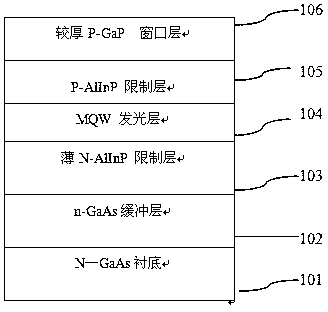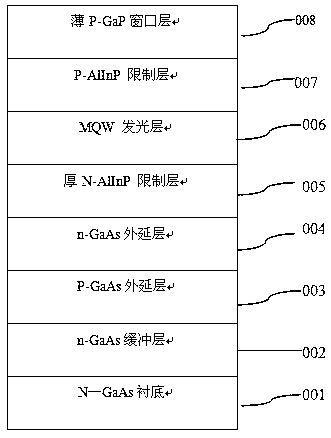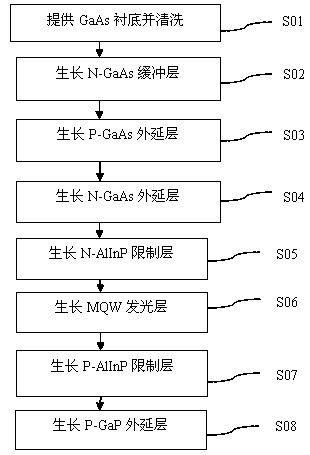A planar LED epitaxial structure based on gallium arsenide substrate and its manufacturing method
An epitaxial structure and gallium arsenide technology, which is applied in the field of planar LED epitaxial structure and its production, can solve the problems of lowering product reliability, falling off of light-emitting units, and difficulty in connecting P-type layers, so as to achieve the effect of current isolation
- Summary
- Abstract
- Description
- Claims
- Application Information
AI Technical Summary
Problems solved by technology
Method used
Image
Examples
Embodiment 1
[0049] S1: Take a 2-inch N-type GaAs substrate, crystal orientation 0 >, the thickness is about 290um, using sulfuric acid: water: hydrogen peroxide = 3:1:1, at a temperature of 45 ° C, chemical cleaning is carried out in the mixture for 2Min, then rinsed with deionized water, and dried with nitrogen after 10Min.
[0050] S2: Put the gallium arsenide substrate prepared in step S1 into the MOCVD epitaxy furnace to grow an N-type GaAs buffer layer with a thickness of about 0.3-1.0um and a carrier concentration of about (1-8)×10 17 , The N-type GaAs buffer layer is used to achieve lattice matching with the GaAs substrate, and provides a fresh interface for the next growth; the N-type GaAs buffer layer is also a GaAlAs buffer layer.
[0051] S3: Grow a P-type GaAs epitaxial layer on the N-type GaAs buffer layer, the thickness of which is in the range of 0.5-2um and the carrier concentration in the range of (1-10)×10 17 . The P-type GaAs layer may also be a P-type GaAlAs layer or ...
Embodiment 2
[0058] S1: Take a 2-inch high-resistance GaAs substrate, the crystal orientation is , the thickness is about 250um, and sulfuric acid: water: hydrogen peroxide = 3:1:1, at 45 ℃ temperature, in the mixed solution for 2Min Chemical cleaning, then rinse with deionized water for 10min, spin dry with nitrogen for use.
[0059] S2: Put the arsenide substrate prepared in step S1 into a MOCVD epitaxy furnace, and grow an N-type GaAs buffer layer with a thickness of about 0.3-1.0um. The N-type GaAs buffer layer is used to achieve lattice matching with the GaAs substrate. , and provides a fresh interface for the next step of growth.
[0060] S3: Grow a P-type GaAs epitaxial layer on the N-type GaAs buffer layer, the thickness of which is in the range of 0.5-2um and the carrier concentration in the range of (1-10)×10 17 . The P-type GaAs epitaxial layer may also be a P-type GaAlAs layer or a GaAlAs / GaAs composite structure.
[0061] S4: grow an N-type GaAs epitaxial layer on the P-typ...
Embodiment 3
[0067] S1: Take a 2-inch intrinsic GaAs substrate, crystal orientation 0 >, the thickness is about 320um, using sulfuric acid: water: hydrogen peroxide = 3:1:1, at 45 ℃, chemical cleaning is carried out in the mixture for 2Min, then rinsed in deionized water for 10Min, and then spin-dried with nitrogen for use.
[0068] S2: Put the arsenide substrate prepared in step S1 into a MOCVD epitaxy furnace, grow a GaAlAs buffer layer with a thickness of about 0.3-1.0um, and then grow an N-type GaAs buffer layer with a thickness of about 0.3-1.0um.
[0069] S3: A P-type GaAs epitaxial layer is grown on the N-type GaAs buffer layer, and its thickness is in the range of 0.5-2um, and the carrier concentration is in the range of (1-10)×10 17 . The P-type GaAs layer may also be a P-type GaAlAs layer or a GaAlAs / GaAs composite structure.
[0070] S4: grow an N-type GaAs epitaxial layer on the P-type GaAs epitaxial layer; the N-type GaAs epitaxial layer is also an N-type GaAlAs layer, or a c...
PUM
| Property | Measurement | Unit |
|---|---|---|
| emission peak | aaaaa | aaaaa |
| emission peak | aaaaa | aaaaa |
| emission peak | aaaaa | aaaaa |
Abstract
Description
Claims
Application Information
 Login to View More
Login to View More - R&D
- Intellectual Property
- Life Sciences
- Materials
- Tech Scout
- Unparalleled Data Quality
- Higher Quality Content
- 60% Fewer Hallucinations
Browse by: Latest US Patents, China's latest patents, Technical Efficacy Thesaurus, Application Domain, Technology Topic, Popular Technical Reports.
© 2025 PatSnap. All rights reserved.Legal|Privacy policy|Modern Slavery Act Transparency Statement|Sitemap|About US| Contact US: help@patsnap.com



